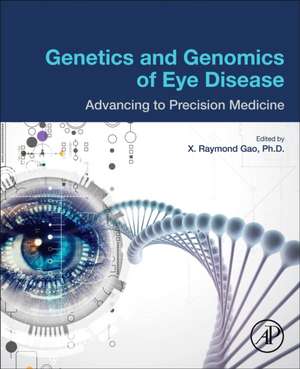Genetics and Genomics of Eye Disease: Advancing to Precision Medicine
Editat de Xiaoyi Raymond Gaoen Limba Engleză Paperback – 13 sep 2019
- Offers thorough guidance on conducting genetic and genomic studies of eye disease
- Examines the genetic basis of a wide range of complex eye diseases and single-gene and Mendelian disorders
- Discusses the application of genetic testing and genetic risk prediction in eye disease diagnosis and patient counseling
Preț: 913.84 lei
Preț vechi: 1181.40 lei
-23% Nou
Puncte Express: 1371
Preț estimativ în valută:
174.86€ • 183.06$ • 144.69£
174.86€ • 183.06$ • 144.69£
Carte tipărită la comandă
Livrare economică 29 martie-12 aprilie
Preluare comenzi: 021 569.72.76
Specificații
ISBN-13: 9780128162224
ISBN-10: 0128162228
Pagini: 383
Dimensiuni: 191 x 235 mm
Editura: ELSEVIER SCIENCE
ISBN-10: 0128162228
Pagini: 383
Dimensiuni: 191 x 235 mm
Editura: ELSEVIER SCIENCE
Public țintă
Pediatric and adult ophthalmologists; human geneticists; basic and translational human genomics researchers; life science researchers, biochemists, and molecular biologists; genetic counselors; ophthalmology residents and trainees; medical geneticists; research students in ophthalmology, human genetics, and precision medicine; medical studentsCuprins
Section I Introduction to gene mapping
1. Timeline of key discoveries in eye genetics
2. Segregation, Linkage, GWAS, and sequencing
Section II Mendelian Disorders and high penetrant mutations
3. Inherited retinal degenerations
4. Early-onset glaucoma
5. Strabismus
Section III Complex disorders and low effect-size risk factors
6. Age-related macular degeneration
7. Adult-onset glaucoma
8. Diabetic retinopathy
9. Kerotoconus
Section IV Genomics in the eye
10. Whole-exome sequencing and whole-genome sequencing
11. RNA-Seq and transcriptome analysis
12. Epigenetics and miRNA regulation
Section V Genetic testing and genetic risk prediction
13. Genetic testing of various eye disorders
14. Genetic risk scores and complex eye disorders
Section VI Gene-based therapy
15. Leber congenital amaurosis
16. CRISPR/CAS9 technology
Section VII Big data and precision medicine
17. Machine learning and artificial intelligence
18. Vision research in multi-ethnic populations
19. Bringing research into the clinic and application to precision medicine
1. Timeline of key discoveries in eye genetics
2. Segregation, Linkage, GWAS, and sequencing
Section II Mendelian Disorders and high penetrant mutations
3. Inherited retinal degenerations
4. Early-onset glaucoma
5. Strabismus
Section III Complex disorders and low effect-size risk factors
6. Age-related macular degeneration
7. Adult-onset glaucoma
8. Diabetic retinopathy
9. Kerotoconus
Section IV Genomics in the eye
10. Whole-exome sequencing and whole-genome sequencing
11. RNA-Seq and transcriptome analysis
12. Epigenetics and miRNA regulation
Section V Genetic testing and genetic risk prediction
13. Genetic testing of various eye disorders
14. Genetic risk scores and complex eye disorders
Section VI Gene-based therapy
15. Leber congenital amaurosis
16. CRISPR/CAS9 technology
Section VII Big data and precision medicine
17. Machine learning and artificial intelligence
18. Vision research in multi-ethnic populations
19. Bringing research into the clinic and application to precision medicine
Recenzii
"Regardless, the book summarises a significant combination of digital inputs – genomic data, fundus images, optical coherence tomography and others – aimed to synthesize enormous information over the coming decade, likely useful to both clinicians and researchers in the field of ocular medicine." --Euretina Brief
"This book is highly specialized and, by nature, it will be difficult to compare. Clearly there are publications in the literature that deal with photographic documentation of genetic eye disorders. This is not an atlas; it is a concise review of knowledge. Great work and congratulations to the contributors and Dr. Gao." --Doody
"This book is highly specialized and, by nature, it will be difficult to compare. Clearly there are publications in the literature that deal with photographic documentation of genetic eye disorders. This is not an atlas; it is a concise review of knowledge. Great work and congratulations to the contributors and Dr. Gao." --Doody
